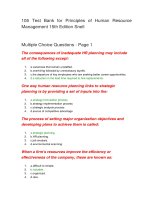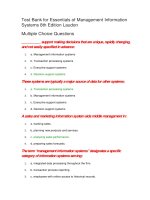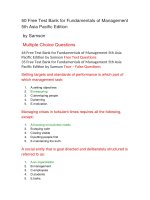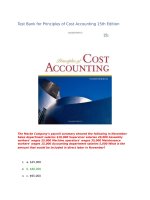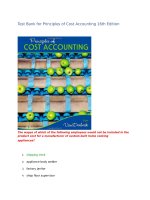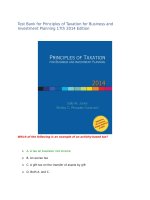204 test bank for principles of management 11th
Bạn đang xem bản rút gọn của tài liệu. Xem và tải ngay bản đầy đủ của tài liệu tại đây (200.6 KB, 34 trang )
Test Bank for Principles of Management 11th
82 Test Bank f True – False Questions
6 Test Bank Free Text Questions
106 Test Bank Multiple Choice Questions
By definition, the operational approach is oriented toward
what area of management?
1.
2.
3.
4.
5.
a) Production
b) Personnel
c) Accounting
d) Finance
e) Marketing
Adopted Fayol's principle of _______ might help a homebuilding company that is very uncoordinated and
unfocused.
1.
2.
3.
4.
5.
a) unity of direction
b) initiative
c) scalar chain
d) authority
e) unity of command
Today, the body of management knowledge is best
characterized as
1.
2.
3.
4.
5.
a) Japan-dominated.
b) experiencing information overload.
c) disappearing.
d) severely limited.
e) unified.
Harmonious effort among individuals is the key to
organizational success, according to Fayol's ________
principle.
1.
2.
3.
4.
5.
a) unity of direction
b) scalar chain
c) equity
d) esprit de corps
e) unity of command
Which of these best describes the field of management?
1.
2.
3.
4.
5.
a) Seriously out of date
b) Applied social science
c) Little more than common sense
d) Highly scientific
e) Interdisciplinary
According to Fayol, the principle of _______ indicates that
the right to give orders must accompany
responsibility.
1.
2.
3.
4.
5.
a) unity of direction
b) discipline
c) unity of command
d) authority
e) scalar chain
Harry Harrison, the CEO of Harrison Printing Company,
remarked in a recent speech that specialization of
labor will be necessary for his company's success.
Which of Fayol's principles of management was he
referring to?
1.
2.
3.
4.
5.
a) Division of work
b) Unity of command
c) Unity of direction
d) Scalar chain
e) Authority
What sort of piece-rate pay plan did Frederick W. Taylor
develop?
1.
2.
3.
4.
5.
a) Conditional
b) Unified
c) Segmented
d) Quasi
e) Differential
_______ is not one of Fayol's 14 universal principles of
management.
1.
2.
3.
4.
5.
a) Esprit de corps
b) Equity
c) Conflict avoidance
d) Authority
e) Centralization
Which of these best describes the historical development of
management thought?
1.
2.
3.
4.
5.
a) Evolution
b) On again, off again
c) Convoluted
d) Hit-and-miss
e) Revolution
Which of the following is not one of the approaches to
management discussed in the text?
1.
2.
3.
4.
5.
a) The systems approach
b) The contingency approach
c) The traditional approach
d) The universal process approach
e) The behavioral approach
Which of these is the universally accepted theory of
management today?
1.
2.
3.
4.
5.
a) The contingency approach
b) The behavioral approach
c) None of these; there is no universally accepted theory of management.
d) The universal process approach
e) The systems approach
Which of Fayol's principles is Belinda, a service manager at
a graphic design company, referring to when she says,
“One of the greatest satisfactions is formulating and
carrying out a plan”?
1.
2.
3.
4.
5.
a) Esprit de corps
b) Centralization
c) Initiative
d) Order
e) Scalar chain
Which of the following refers to who is ultimately
responsible for getting things done?
1.
2.
3.
4.
5.
a) Specialization of labor
b) Command center
c) Communication
d) Authority
e) Delegation
Taylor claimed, during his pig iron handling experiments, to
have dramatically improved output by
1.
2.
3.
4.
5.
a) hiring only weight lifters.
b) cutting the size of the standard iron “pig” in half.
c) eliminating half the walking distance.
d) automating the process to eliminate human labor.
e) having the workers rest more than they worked.
Which approach is useful because it specifies what
managers should do?
1.
2.
3.
4.
5.
a) Functional
b) Operational
c) Systems
d) Contingency
e) Behavioral
When Taylor's studies revealed the optimum shovel load to
be 21 pounds, he
1.
2.
3.
4.
5.
a) automated the process to eliminate human labor.
b) invented a steam-powered shoveling machine.
c) replaced workers' personal shovels with standardized company shovels.
d) developed the ideal shovel for all tasks.
e) replaced all the shovelers with harder workers.
What is the key word that captures the spirit of scientific
management?
1.
2.
3.
4.
5.
a) Capitalism
b) Experimentation
c) Communication
d) Cooperation
e) Indoctrination
The _______ approach is the oldest and one of the most
popular approaches to management thought.
1.
2.
3.
4.
5.
a) universal process
b) contingency
c) operational
d) systems theory
e) behavioral
To reduce employee confusion, Moonlight Manufacturing
recently instituted a policy stating that an employee
should receive orders from only one supervisor. Which
of Fayol's principles of management is related to this
policy?
1.
2.
3.
4.
5.
a) Esprit de corps
b) Common purpose
c) Scalar chain
d) Authority
e) Unity of command
Zildjian has an estimated _______ percent of the world
cymbal market.
1.
2.
3.
4.
5.
a) 19
b) 33
c) 45
d) 65
e) 80
The universal process approach assumes that
1.
2.
3.
4.
a) it is more difficult to manage public organizations.
b) small organizations are hardest to manage.
c) management is not practiced in small organizations.
d) managing in public organizations and managing in private organizations are
completely different.
5. e) managing in public organizations and managing in private organizations are
basically the same.
_______ involves “who does what.”
1.
2.
3.
4.
5.
a) Span of control
b) Authority
c) The specialization of labor
d) The chain of command
e) Communication
Betsy Duvall believes that a combination of kindliness and
justice will lead to a staff that is devoted and loyal.
This belief is in accordance with which of Fayol's
principles of management?
1.
2.
3.
4.
5.
a) Discipline
b) Stability and tenure of personnel
c) Centralization
d) Scalar chain
e) Equity
_______ involved developing performance standards on the
basis of systematic observation and experimentation.
1.
2.
3.
4.
5.
a) Fayol's universal principles
b) Therbligs
c) Gantt charts
d) Scientific management
e) Total quality control
Frederick W. Taylor focused his work on all of the following
except
1.
2.
3.
4.
5.
a) standardization.
b) group dynamics.
c) time and task study.
d) systematic selection and training.
e) pay incentives.
Which of the following is one of Fayol's POC3 functions?
1.
2.
3.
4.
5.
a) Control
b) Cooperation
c) Budgeting
d) Leading
e) Communicating
Which assumption led Taylor to believe that piece rates were
important to improved productivity?
1.
2.
3.
4.
5.
a) Social network
b) Economic man
c) Behavioral approach
d) Irrational man
e) Systems approach
The pioneering contributors to management theory and
practice come from
1.
2.
3.
4.
5.
a) the Eastern Hemisphere.
b) the United States.
c) the Western Hemisphere.
d) the Third World countries.
e) around the globe.
Zildjian is guided by their core value, which include all of the
following except
1.
2.
3.
a) a focus on continuous improvement.
b) a Six Sigma quality program.
c) empowering employees.
4.
5.
d) innovation.
e) craftsmanship.
According to Taylor, what do workers want, above all else,
from their employers?
1.
2.
3.
4.
5.
a) High wages
b) Interesting work
c) Friendly treatment
d) Participation in decision making
e) Clean and safe working conditions
Which approach is also known as the functional approach to
management?
1.
2.
3.
4.
5.
a) Systems approach
b) Behavioral approach
c) Excellence approach
d) Universal process approach
e) Operational approach
Management, as an area of academic study, is essentially a
product of
1.
2.
3.
4.
5.
a) the sixteenth century.
b) the twentieth century.
c) the British industrial system.
d) trial and error.
e) corporate America.
Historical perspective is said to sharpen our vision of
1.
2.
3.
4.
5.
a) the long-term future.
b) both past and future.
c) what we need to learn.
d) the present.
e) the past.
Brady Hoyts, owner of Hoyts Inc., recently posted data for
employees on the optimum speed and rate at which
stock should be fed into machines for each job. This
exemplifies which of Frederick W. Taylor's areas of
study?
1.
2.
3.
4.
5.
a) Human relations study
b) Time and task study
c) Standardization
d) Selection and training
e) Pay incentives
What most influenced Frenchman Henri Fayol's management
writings?
1.
2.
3.
4.
5.
a) Chester I. Barnard
b) His experience as an administrator
c) His 30 years as a college professor
d) His military experience
e) His wife, Mary Parker Follett
106 Free Test Bank for Principles of Management
11th Edition Robert Kreitner Multiple Choice
Questions - Page 2
_______ cautioned managers that emotional factors were a
more important determinant of productive efficiency
than physical and logical factors.
1.
2.
3.
4.
5.
a) Chester I. Barnard
b) W. Edwards Deming
c) Henry L. Gantt
d) Joseph M. Juran
e) Elton Mayo
Simon believes, as a manager, that cooperation, a spirit of
unity, and self-control are the keys to both productivity
and a democratic way of life. This philosophy
exemplifies the ideas of
1.
2.
3.
4.
5.
a) Chester I. Barnard.
b) Frederick W. Taylor.
c) W. Edwards Deming.
d) Douglas McGregor.
e) Mary Parker Follett.
Which of the following recommendations concept most
closely parallels Philip Crosby's idea of zero defects?
1.
2.
3.
4.
5.
a) Get top-management support for quality improvement.
b) Find lots of reliable suppliers.
c) Listen to the customer.
d) Involve the entire organization.
e) Do it right the first time.
The Hawthorne studies can be credited with turning
management theorists away from the "_______" model
and toward the "_______" model of the average
working person.
1.
2.
3.
4.
5.
a) political man; social man
b) hedonistic man; economic man
c) social man; economic man
d) psychological man; political man
e) economic man; social man
After the Wagner Act was passed in 1935, U.S. business
managers began adopting morale-boosting human
relations techniques as a(n)
1.
2.
3.
4.
5.
a) operations management technique.
b) union-avoidance tactic.
c) way to avoid pay raises.
d) experiment in scientific management.
e) public relations ploy.
_______ developed the concept of total quality control.
1.
2.
3.
4.
5.
a) W. Edwards Deming
b) Philip B. Crosby
c) Joseph M. Juran
d) Armand V. Feigenbaum
e) Kaoru Ishikawa
_______ were included in Kaoru Ishikawa's idea of the
customer.
1.
2.
3.
4.
5.
a) Primarily suppliers
b) Competitors
c) Hourly employees only
d) Both internal and external customers
e) External customers only
Among the following, who was not a pioneering advocate of
quality?
1.
2.
3.
4.
5.
a) Joseph M. Juran
b) Walter A. Shewhart
c) W. Edwards Deming
d) Kaoru Ishikawa
e) Peter Drucker
According to Fiegenbaum, the __________ is the one who
ultimately determines quality.
1.
2.
3.
4.
5.
a) employee
b) competitor
c) top manager
d) government
e) customer
_______ and early proponents of scientific management
have been roundly criticized for viewing workers as
mechanical economic beings interested only in more
money.
1.
2.
3.
4.
5.
a) Crosby
b) Deming
c) Taylor
d) Feigenbaum
e) McGregor
The Hawthorne studies found _______ to be the most
significant factor in worker productivity.
1.
2.
3.
4.
5.
a) labor union activities
b) size of the work group
c) pay levels
d) relations among employees, peers, and supervisors
e) lighting
Frank and Lillian Gilbreth, following in Taylor's footsteps,
turned _______ into an exact science.
1.
2.
3.
4.
5.
a) motion study
b) human relations
c) motivation
d) labor relations
e) upward communication
Jessica Jameson is an old-fashioned supervisor for a local
bank who sums up her management philosophy by
saying, “My people are basically lazy and it's my job to
tell them what, when, and how to do things. In fact,
they want to be told what to do.” What label would
McGregor have applied to Ms. Jameson?
1.
2.
3.
a) Theory Z
b) Theory X
c) Ineffective
4.
5.
d) Task-motivated
e) Theory Y
How did Henry L. Gantt humanize Taylor's differential pay
system?
1.
2.
3.
4.
5.
a) By paying everyone the same
b) By introducing a minimum wage
c) By paying employees in cash
d) By eliminating bonuses
e) By introducing hourly wages
According to advocates of _______, the central focus of
organized activity should be people.
1.
2.
3.
4.
5.
a) the operations approach
b) scientific management
c) the universal process approach
d) the behavioral approach
e) quality control management
What did Frank and Lillian Gilbreth mean by “therbligs”?
1.
2.
3.
4.
5.
a) Types of employment experience
b) Workers' hand motions
c) Units of time
d) Bricks
e) Educational units
Which of the following is an important post-World War II
outgrowth of the operational approach?
1.
2.
3.
4.
5.
a) Behavioral management
b) Scientific management
c) Contingency management
d) Quality control management
e) Operations management
Advice from quality advocates finally began to sink in during
the _______ in the United States.
1.
2.
3.
4.
5.
a) 1970s
b) 1960s
c) 1980s
d) 1950s
e) 1990s
Walter A. Shewart introduced
1.
2.
a) the differential piece-scale system.
b) a focus on internal customers.
3.
4.
5.
c) Pareto analysis.
d) the concept of statistical quality control.
e) the zero-defect concept.
_______ is also known as the 80/20 rule.
1.
2.
3.
4.
5.
a) Linear programming
b) Pareto analysis
c) Contingency planning
d) Fishbone analysis
e) Strategic scanning
W. Edwards Deming recommended _______ improvement for
all types of operations.
1.
2.
3.
4.
5.
a) continuous
b) segmented
c) economic
d) training
e) parallel
_______ helped support the human relations movement.
1.
2.
3.
4.
5.
a) General systems theory
b) Fayol's universal principles
c) Gantt charts
d) The threat of unionization
e) Statistical process control
By today's standards, the _______ label best fits Taylor's
scientific management.
1.
2.
3.
4.
5.
a) open-systems thinking
b) contingency management
c) labor exploitation
d) systematic management
e) human relations
_______ managers could be called the frontline troops in the
battle for productivity growth.
1.
2.
3.
4.
5.
a) Contingency
b) Operations
c) Scientific
d) Upper-level
e) New
_______ is the process of transforming material and human
resources into useful goods and services.
1.
a) Contingency management
2.
3.
4.
5.
b) Scientific management
c) Operations management
d) Behavioral management
e) Quality control management
Henry L. Gantt emphasized the importance of ___________
and urged management to concentrate on service
rather than ____________.
1.
2.
3.
4.
5.
a) the human factor; profits
b) manufacturing; profits
c) profits; the production factor
d) manufacturing; communication
e) security; profits
Which word best describes McGregor's Theory X?
1.
2.
3.
4.
5.
a) Modern
b) Traditional
c) Optimistic
d) Progressive
e) Positive
The _______ was a concerted effort among theorists and
practitioners to make managers more sensitive to their
employees' needs.
1.
2.
3.
4.
5.
a) operations approach
b) human relations movement
c) systems movement
d) universal process approach
e) excellence movement
Jeanetta recently told her production employees that they
have the authority to stop the production line if they
spot problems. This exemplifies the approach of which
quality advocate?
1.
2.
3.
4.
5.
a) W. Edwards Deming
b) Thomas J. Peters
c) Mary Parker Follett
d) Frederick W. Taylor
e) Peter Drucker
_______ is a popular problem-solving tool developed by
Kaoru Ishikawa.
1.
2.
a) Pareto analysis
b) The EOQ model
3.
4.
5.
c) The fishbone diagram
d) The zero-defect system
e) Linear programming
Mary Parker Follett urged managers to
1.
2.
3.
4.
5.
a) share profits equally with workers.
b) adopt a Theory X view of workers.
c) ignore the findings of the Hawthorne studies.
d) get rid of the traditional hierarchy of authority.
e) motivate workers rather than simply demanding performance.
106 Free Test Bank for Principles of Management
11th Edition Robert Kreitner Multiple Choice
Questions - Page 3
Daniel Beam believes that many people in the general
population have imagination, ingenuity, and creativity.
This is what kind of an assumption?
1.
2.
3.
4.
5.
a) Theory Y
b) Theory X
c) Type A
d) Type B
e) Positivist concept
________ is a _______ of human relations.
1.
2.
3.
4.
5.
a) Organizational behavior; practical extension
b) Contingency management; subfield
c) Organizational behavior; scientific extension
d) Operations management; practical extension
e) Scientific management; foundation
Will and Grace were very impressed by the concept of total
quality control. _______ should get historical credit for
this concept.
1.
2.
3.
4.
5.
a) Armand V. Feigenbaum
b) Kaoru Ishikawa
c) Joseph M. Juran
d) W. Edward Deming
e) Walter A. Shewhart
_______ energized Chester I. Barnard's early systems theory
of the organization.
1.
2.
a) Interpersonal trust
b) Communication
3.
4.
5.
c) Labor-management cooperation
d) Human motivation
e) Individual needs
Because of the influence of _______, managers now have
greater appreciation for the importance of seeing the
whole picture.
1.
2.
3.
4.
5.
a) multivariate analysis
b) the behavioral approach
c) the contingency approach
d) matrix theory
e) the systems approach
Grace's beliefs reflect which one of McGregor's labels?
1.
2.
3.
4.
5.
a) Theory Y
b) Theory X
c) Task-motivated
d) Relations-motivated
e) Theory Z
Which of the following is a modern approach seeking to
discover the causes of work behavior and to develop
better management techniques?
1.
2.
3.
4.
5.
a) Organizational behavior
b) The systems approach
c) The universal process approach
d) The operational approach
e) Scientific management
The popularization of management shifted into high gear in
1982 with the publication of Peters and Waterman's
book
1.
2.
3.
4.
5.
a) The Apprentice.
b) In Search of Excellence.
c) The One Minute Manager.
d) High Output Management.
e) Good to Great: Why Some Companies Make the Leap ... and Others Don't.
Management is studied by _______ theorists, who put things
together and assume that the whole is greater than the
sum of its parts.
1.
2.
3.
a) systems
b) universal process
c) human relations
4.
5.
d) behavioral
e) scientific management
The traditional human relations doctrine has been criticized
1.
2.
3.
4.
5.
a) as a closed system.
b) as vague and simplistic.
c) as too complex.
d) as monocultural.
e) as old-fashioned.
The _______ approach makes it clear to managers that
people are the key to productivity.
1.
2.
3.
4.
5.
a) behavioral
b) scientific management
c) operations management
d) contingency
e) systems
The author calls managers
1.
2.
3.
4.
5.
a) overworked and undereducated.
b) lazy.
c) reluctant heros.
d) closed-sytsem thinkers.
e) pragmatists who use whatever works.
To avoid the quick-fix mentality, managers are advised to
read management journals that
1.
2.
3.
4.
5.
a) report nonquantitative studies.
b) report highly controlled laboratory studies.
c) report the results of public opinion polls.
d) translate research into practice.
e) specify how-to-do-it procedures.
Organizations are what type of system?
1.
2.
3.
4.
5.
a) Independent
b) Specialized
c) Closed
d) Functional
e) Open
Successful managers use which approach to management?
1.
2.
3.
4.
5.
a) Modified contingency
b) Mixed bag
c) Closed-systems
d) Incremental
e) Contingency
_______ is a characteristic of the contingency approach to
management.
1.
2.
3.
4.
5.
a) The open-system perspective
b) Bivariate analysis
c) The closed-system view
d) Pure theory
e) The Theory X view
Which of the following terms refers to a simple one-to-one
causal relationship?
1.
2.
3.
4.
5.
a) Open-system analysis
b) Univariate analysis
c) Bivariate analysis
d) Multivariate analysis
e) Contingency analysis
A(n) ________ depends on the surrounding environment for
survival, whereas, a(n) _________ is a self-sufficient
entity.
1.
2.
3.
4.
5.
a) universal system; specific system
b) open system; closed system
c) general system; closed system
d) open system; general system
e) closed system; open system
Which term applies to the interdisciplinary area of study
based on the assumption that everything is part of a
larger, interdependent arrangement?
1.
2.
3.
4.
5.
a) Equifinality
b) General systems theory
c) Dynamic equilibrium
d) Closed-systems theory
e) Chaos theory
Monica is a storeowner who tells a management class that
she tries to match the appropriate management
technique to each situation. What is her general
approach to management?
1.
2.
3.
4.
5.
a) Systems
b) Excellence
c) Scientific management
d) Universal process
e) Contingency
Tony Daniels has an open-system perspective, has a
practical research orientation, and uses a multivariate
approach in his decision making. Tony is a
___________ advocate.
1.
2.
3.
4.
5.
a) scientific management
b) management-by-best-seller
c) contingency management
d) quality control
e) human relations
What does the author recommend that future managers
use?
1.
2.
3.
4.
5.
a) A quasi-systems approach
b) The approach they themselves find most useful
c) A universal contingency approach
d) The excellence approach
e) A Theory Y approach
Which word best conveys the meaning of the term
"system"?
1.
2.
3.
4.
5.
a) Predictable
b) Contingent
c) Interdependent
d) Circular
e) Independent
Which of the following portrays the organization as a living
and thinking system?
1.
2.
3.
4.
5.
a) Theory Y
b) Matrix theory
c) Scientific management
d) Operations management
e) Organizational learning
Regarding the evolution of management thought, the author
calls the contingency approach
1.
2.
3.
4.
5.
a) a detour.
b) the final word.
c) a promising step.
d) only the beginning.
e) a confusing digression.
_______ is credited with bringing management by best-seller
into the mainstream.
1.
2.
3.
4.
5.
a) Mary Parker Follett
b) Frederick W. Taylor
c) Stephen R. Covey
d) Jack Welch
e) Peter F. Drucker
Authors of business best-sellers have been criticized by
researchers for fostering a _______ mentality.
1.
2.
3.
4.
5.
a) quick-fix
b) closed-system
c) success-at-any-cost
d) wasteful
e) multinational
Which statement most accurately captures the meaning of
chaos theory?
1.
2.
3.
4.
5.
a) There is unknowable complexity in the natural world.
b) Failure can emerge from apparent success.
c) There is order among seemingly random patterns.
d) There is no rational order in the natural world.
e) There is complete predictability in the natural world.
_______ best describes the contingency approach.
1.
2.
3.
4.
5.
a) Differential management
b) Managerial similarity
c) Situational management
d) Continuous improvement
e) One best way to manage
Which of these approaches to management does the
production-oriented management session attended by
Will and Grace at the conference reflect?
1.
2.
3.
4.
5.
a) The contingency approach
b) The operational approach
c) The behavioral approach
d) The systems approach
e) The universal process approach
According to Barnard's early systems theory, a natural gap
exists between _______ and the organization's
common purpose.
1.
a) personal needs and motives
2.
3.
4.
5.
b) standard administrative procedures
c) technology
d) the individual's willingness to serve
e) group norms
The contingency approach lies midway between the systems
approach and
1.
2.
3.
4.
5.
a) closed-systems theory.
b) the purely situational approach.
c) chaos theory.
d) the excellence approach.
e) organizational behavior.
According to which theory should change be controlled by
minimizing uncertainty and tension, limiting
information, and centralizing decision making?
1.
2.
3.
4.
5.
a) Contingency
b) Classical management
c) Complex adaptive systems
d) Human relations
e) Information dynamics
McAllaster's critique of management by best-seller warns of
1.
2.
3.
4.
5.
a) pie-in-the-sky academic research.
b) one-size-fits-all solutions.
c) get-rich-quick schemes.
d) outdated research.
e) too much theory.
Which of these approaches to management represents a
focus on employee needs?
1.
2.
3.
4.
5.
a) The behavioral approach
b) The contingency approach
c) The systems approach
d) The operational approach
e) The universal process approach
Will's argument that most people prefer to be directed would
be classified by McGregor as which of these?
1.
2.
3.
4.
5.
a) Ineffective
b) Theory Y
c) Theory Z
d) Theory X
e) Excellence in management
Which label best describes a closed system?
1.
2.
3.
4.
5.
a) Interdependent
b) Self-sufficient
c) Large
d) Universal
e) Environmentally dependent
What do systems theorists recommend because
management is not practiced in a vacuum?
1.
2.
3.
4.
5.
a) A one-way process
b) A closed environment
c) Command-and-control techniques
d) Synthetic thinking
e) Taking a unionized approach
Barbara, a district manager at Subtle Segments Inc., remarks
that “my employees are creative, imaginative, and
capable of self-direction and self-control.” What label
would McGregor have applied to Barbara?
1.
2.
3.
4.
5.
a) Theory Z
b) Idealistic
c) Relations-motivated
d) Theory Y
e) Theory X
81 Free Test Bank for Principles of Management
11th Edition Robert Kreitner True - False
Questions - Page 1
The father of scientific management was Elton Mayo.
1.
2.
True
False
The Pareto analysis was introduced through Deming's book
Out of the Crisis.
1.
2.
True
False
Management is a forward-looking field and history doesn't
matter.
1.
2.
True
False
Management was something one learned, in early cultures,
by word of mouth and trial and error, rather than
something one studied.
1.
2.
True
False
Frank and Lillian Gilbreth were dedicated to finding the one
best way to do every job, including tasks they
performed at home with their 12 children.
1.
2.
True
False
According to Fayol's unity-of-command principle, each
employee should receive orders from only one
superior.
1.
2.
True
False
The organizational computer network is referred to as the
chain of command.
1.
2.
True
False
By taking a historical perspective, we can gain a better
understanding of the present.
1.
2.
True
False
Throughout its historical development, the operational
approach has been technically and quantitatively
oriented.
1.
2.
True
False
The field of management is experiencing information
overload.
1.
2.
True
False
Scientific management tends to be broader in scope and
application than operations management.
1.
True
2.
False
Frederick W. Taylor is considered the father of scientific
management.
1.
2.
True
False
Operations management specialists apply their expertise to
all types of production and service operations,
whereas scientific management was limited largely to
hand labor and machine shops.
1.
2.
True
False
Philip B. Crosby promoted the concept of a fishbone
diagram, or doing it right the first time.
1.
2.
True
False
Japan's Kaoru Ishikawa considered both internal and
external customers when improving quality.
1.
2.
True
False
Traditional scientific management held that workers produce
more when paid by the hour.
1.
2.
True
False
Fayol's scalar chain stated that subordinates should observe
the formal chain of command unless expressly
authorized by their respective superiors to
communicate with each other.
1.
2.
True
False
Quality, according to Armand V. Feigenbaum, is determined
by the customer.
1.
2.
True
False
According to Henri Fayol, the manager's job can be divided
into planning, organizing, communicating, motivating,
and controlling.
1.
2.
True
False
Scientific management often appears unscientific to those
who live in a world of genetic engineering and
industrial robots.
1.
2.
True
False
A "therblig," according to the Gilbreths, was a standard unit
of time for measuring productivity.
1.
2.
True
False
Taylor believed, as a pioneering advocate of employee
rights, in letting workers determine their own way of
doing tasks.
1.
2.
True
False
According to the functional approach, the administration of
public organizations and the administration of private
organizations require distinctly different processes.
1.
2.
True
False
Management has been practiced in one form or another for
thousands of years.
1.
2.
True
False
The contingency approach is the only universally accepted
theory of management.
1.
2.
True
False
According to Frank and Lillian Gilbreth, "What the workmen
want from their employers beyond anything else is
high wages."
1.
2.
True
False
A Pareto analysis looks for the 20 percent of possible causes
that lead to 80 percent of all problems.
1.
2.
True
False
Zildjian has a secret strategic formula that has made the firm
the world's largest cymbal maker.
1.
2.
True
False
The interdisciplinary nature of management is a principal
cause of the information explosion in management
theory.
1.
2.
True
False
Standardization, time and task study, systematic selection
and training, and pay incentives were all areas in
Taylor's scientific management movement.
1.
2.
True
False
Coordination is one of Fayol's five universal management
functions.
1.
2.
True
False
Fayol's managerial functions teach why and how modern
managers behave.
1.
2.
True
False
Contributors to management theory and practice have come
from around the globe.
1.
2.
True
False

